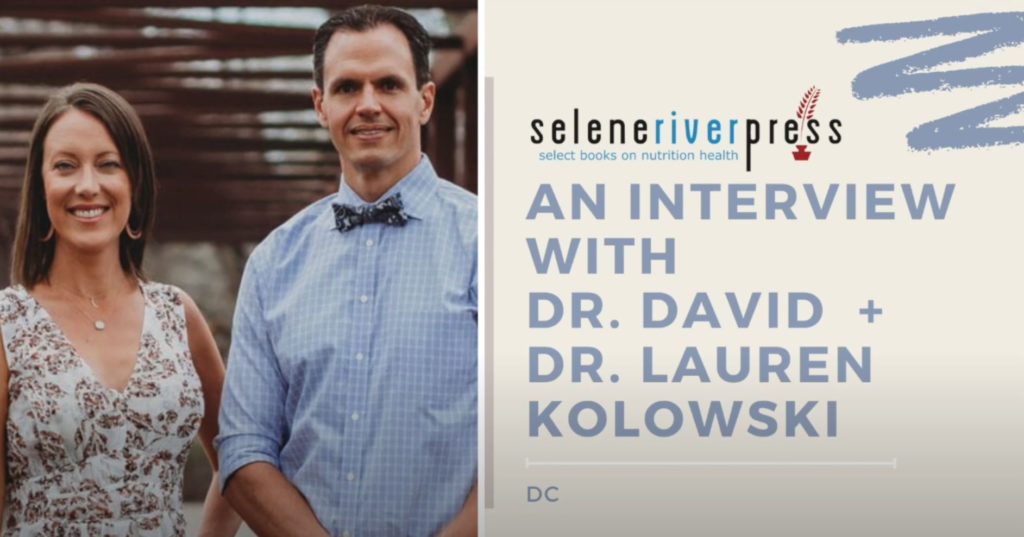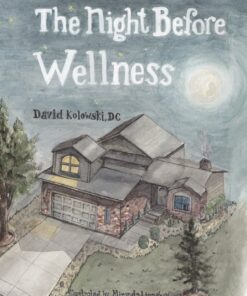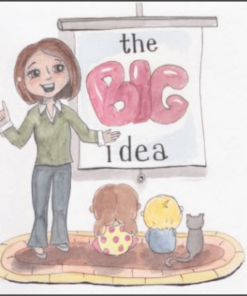Welcome to the latest installment of our Selene River Press Practitioner Interviews. This time around SRP managing editor Danielle LeBaron sat down for a fascinating conversation with Lauren Kolowski, DC, and David Kolowski, DC, author of The Night Before Wellness. This dynamic husband-and-wife team are devoted to helping people ask better questions and enhance their health naturally. The Kolowski’s spoke to Danielle of moms and kids, the past and the present, and why we should all stay curious.
To listen to the interview, click here.
Danielle LeBaron: Welcome to Selene River Press Practitioner Interviews, a series of short conversations with some of our most prominent writers and practitioners. Today we have the pleasure of speaking with Drs. Lauren and David Kolowski. Hello! Thank you both so much for being here. How are we doing?
Dr. Lauren Kolowski: Great. How are you?
Danielle: I’m very well, thanks. I’m excited to talk to you and get to know you both a little better. Can you talk a bit about yourself, your practice, and your skill set?
Dr. David Kolowski: Sure. So we both graduated from the Palmer College of Chiropractic in 2010, and what brought us there was just an interesting string of sequences. Initially, Dr. Lauren was encouraged by her chiropractor back home in Nebraska to think about chiropractic as a profession—
Lauren: Dr. Michael Dority.
David: Yes.
Danielle: Really? No way!
Lauren: We have to say his name.
Danielle: Wow. That’s a really fun piece of information to know. We love Dr. Dority.
David: Another one of your authors and content creators.
Danielle: Yes.
David: Amazing guy. Amazing practice. He put the bug in Lauren’s ear about chiropractic school. Eventually, she had to come to the decision post-undergrad to figure out what would be the next step—and that was it. We were dating at the time, and I was kind of looking over her shoulder at this whole chiropractic world. It was very intriguing to be able to do something so meaningful, effective, and cost-effective for people and their health. That’s always been an underlying passion of mine—sports, athleticism, and health and wellness in general. So it just all came together with chiropractic as a profession. We both dove into it, ended up graduating together, and started our practice here in Loveland back in April 2010. It’s grown very organically, through a lot of word of mouth, a lot of trial and error, and through advertising. Now here we are today with a strong nutrition and chiropractic practice. We have two other practitioners and four or five other team members.
Danielle: That’s a pretty solid operation.
David: Yeah, we like it. Our patients not only get great results, but they’re also advocates for us. It’s been a great last decade.
Danielle: How wonderful—Dr. Dority inspired Dr. Lauren, and Dr. Lauren inspired you. Look at the trickle effect. And now you have a practice with—you said two other practitioners and five team members? What an amazing legacy. I had no idea! All right, let’s jump into your product. I want to talk a little bit about The Night Before Wellness. What inspired you to create it?
David: Well, initially, it was just a little Christmas poem that I put together. I had The Night Before Christmas running through my head. And it was on a Christmas morning that I finally just sat down and started writing some of the lines out. Within a matter of like, I don’t know, an hour or two, it was out.
Lauren: I came down the stairs and he’s at the kitchen table. And I’m like, “What are you doing?” I’m half asleep. And poof, it was done!
David: Initially, I shared it online with some social media friends, and it was immediately very popular. I sat on it for a year or two, and then I approached Stephanie and Selene River Press to asked if there was any potential to make it into a Christmas booklet. And she said why not just retool it to give it more of a year-round kind of feel? Take the Christmas aspect out and add in some nutritional advice as well. One thing led to another. We found a great artist. And we just ended up putting it all together. And here it is.
Danielle: I love that you talked about the artwork. It’s one of my favorite parts of the booklet. It’s such fun, with hippos and the table full of food that the kids get to color.
Lauren: She did an amazing job, Miranda. [Miranda Linnehan, illustrator of The Night Before Wellness.]
David: Yeah, she ran with it. Miranda took very little cues and directions from us. She had a great intuitive eye for those kinds of things. It turned out to be a really fun product that we use all the time in our office. Every new patient gets a copy.
Danielle: I love that you give it to every new patient. What a great idea. And it’s a nice way to transition to my next question. Who would you say is your best audience for the booklet? And going off that, how can other practitioners incorporate it into their own practice?
Lauren: Moms!
David (laughing): Yeah.
Lauren: Mom and her kids, you know?
David: Yep, kids love it. They’re drawn to these kinds of cartoony-like books. But for the parents who also read it, it’s packed full of all kinds of core philosophical ideas for chiropractic—and for health in general. I skimmed the surface with a lot of these ideas, so I encourage the doctors who use the booklet to go on a deeper dive with their patients on a one-on-one basis. Or they could read it to their clientele on their own social media, or take little snippets and just expand on those ideas. That’s what I like to do when I’m working with my patients, and the kids as well. Plant that little seed. Your body is designed to work this way. Here’s how it all runs. And here’s what you can do to help make sure it works better and keeps you at your best. It leads to a lot of other discussions and conversations, if you use it correctly.
Danielle: That’s a good point, planting that seed to help lead to other conversations. One thing that you mentioned is that you hand it out to your patients. That’s also a great idea for other practitioners to do. These make great little handouts.
Lauren: We have new patient packets with many things in it, but the booklet is the most prominent. There are other seeds of information—brochures from Standard Process and our in-house brochure of chiropractic information. But why wouldn’t they want to open the pamphlet and start with a little bit of fun? And like we were talking about, it plants the seed, and you can go into further investigation from there.
Danielle: Great idea.
David: We also have it at public events we do, speaking engagements, those kinds of things. We’ll usually have a speaker’s table, or somewhere we can put our business cards, but there is always a stack of those books as well. And other offices that use the books can put their label on the back. There’s a spot just for that. And now they can pass out something that has value to people. It doesn’t cost a lot, but it’s also not something you’d toss in the trash once you get home. People will hold on to a book more than they’ll hold on to business cards.
Danielle: You had mentioned mothers earlier. Obviously, this book is geared towards children, but why is it good for mothers and parents as well?
David: Well—
Lauren: Mom is the head of the household for health.
Danielle: That is well said. I love that.
Lauren: Most of the time, Mom makes the health decisions. She takes care of the health research and all those things. So in our clinic, we feel like if we can get to Mom, we can get to the people we really want to get to—the kids. You don’t get to the kids without Mama trusting you, right? It’s a gateway into educating Mom, so she can educate her kids. The reality is, if we can get a hold of the kids now, before any health concerns, it’s a win-win.
Danielle: Absolutely. I feel like as a mom, it’s not just the nutrition. It’s also that pressure to teach nutrition to bored little children who are running around. I know I struggle with that. So what a great idea—these fun pictures, the hippos, what the body looks like. All of that really is a win-win when it comes to kids. Let’s talk about childhood nutrition a bit more. What are some of the most common complaints or concerns that you’re getting from parents about their children and nutrition and wellness?
David: Wow, that’s a big question. Where to start?
Lauren: Heart concerns in little boys that can look like earaches.
Danielle: Oh, wow, okay.
Lauren (whispering): Cardio-Plus
David: A lot of those things are discovered through the Nutrition Response Testing we do in our office. It’s not something that intuitively comes across in the literature.
Lauren: But one of the most recommended, tested, necessary nutrients for children is Cardio-Plus. And back to your questions, it’s digestive concerns, sleep, behavior. Which is, sadly, the top complaint from mom and dad. Many factors that involve that. Inflammatory foods, toxins, our kids’ modern lives. Obviously, chiropractic care is so essential for stressed-out little kids. Calming nutrition, growth and development nutrition, heart support, thyroid support, general nutrition for this time of year—calcium, vitamin D. Similar to adults.
David: I think every parent and every mom wants the best for their kids. So they’re always trying to gain new knowledge and stay one step ahead of the curve. But we live incredibly busy, crazy lives, or at least the vast majority of us do. It’s hard to not only keep up with that information, but also to keep up with the household in general. So what do we do? We default to the quick, easy snack foods, the junk foods, the quick drive-thru things that are out there. One dose isn’t going to hurt you too bad, but a lifetime of that, or even a month or a year of that, and you’ll start to see those effects, just like Dr. Lauren was talking about with behavior, energy, sleep, immune system function, and all those kinds of things. I think for most parents, we don’t want to reflexively go from crisis to crisis. We want some rational, solid answers.
Lauren: And simple answers. Again, when we’re working on kiddo, we think of compliance of what Mom and Dad are able to get done within their crazy lifestyle. So step one: let’s get them in for adjustments several times a month. Step two: these are the things we’re going to eliminate or limit from your diet. Step three: these are the things we could eat more of. And step four: here are a few supplements that will take it that much further.
David: And going back to the underlying framework of The Night Before Wellness, I want to help make it simple for people to understand. If you do these few simple things on a regular basis: you eat well, you move well, you get adjusted, you sleep—all of foundational lifestyle things everybody needs to do, but most people do poorly. But if we do them, especially starting young, we can avoid the vast majority of health issues and have that much better health right now.
Danielle: Well said. I liked how you broke that up into simple steps. I know, as a mom, those are “ding” words that make me listen, and I feel much better about it. I think we’ve talked about this, but just to bring it back. If you had one piece of advice that you would give to a parent to help them with child wellness, what would it be?
David, turning to Lauren: Hmmm, what do you think? So many things again—
Danielle: I know, it’s hard.
Lauren: Nutrition and sleep. I feel like for our kids, half of their problems are because they’re not rested.
David: Yeah, they start school way too early in the day. Their biological clock doesn’t match up with that school schedule. But I think if there’s one core thing, it’s just to stay curious. Don’t go full in on an idea or a concept and stop thinking critically about it. Analyze it every day. Are you seeing the results you’re looking for? Are you on the right track? If not, we need to make some changes, but they need to fit along the path of what is natural is best. We need to look at our food, look at our environment, look at our daily activities, look at how we move and at our core neurological function. I know that’s kind of a big concept. But that’s chiropractic for you. Just be open to the idea that there is something newer or better that can help get you where you want to go. But oftentimes, those new things take you back to the core, foundational, traditional ideas.
Lauren: Exactly—newer might actually mean older. There are times when you’ll see research that says, This is really good for you. And we’re going, Dr. Lee said that a long time ago. We got away from that, and now research is going back to it. When we look at supplements, nutrition, sleep, food, movement, chiropractic, we are looking back to the old nutritional guidelines. These foundational experts followed the truth of what they were learning with the processing of our food supply and the changing of life as we know it in America.
David: Yes. In a lot of the articles that I’ve written since Night Before Wellness, one of the main ideas I try to come at is to not get so buried deep in the newest literature, the newest science. Try to tie in these new ideas with the foundational, core principles of health and wellness that we’ve been exploring for thousands of years.
Danielle: That’s a really good point. I feel like a lot of times we get stuck in, “Well, look at how far everything is advanced. Let’s see what’s new.” But it’s important to remember that we’ve lost a lot of the value of the old, and now we need to bring it back into the new. What a great point.
This has been fabulous. I’ve learned so much about you that I didn’t know. As a mother, even just after this interview, I even feel more empowered with my children. I love how much you focus on moms. That was a good one for me and just for parents in general. Thank you for talking to us. Before we wrap up, is there anything else you’d like to share?
David: Stay curious. Stay thirsty for new ideas, new information. Tap into Selene River Press—look at their catalog and the archives. We’re always discovering great information through Selene River Press and Standard Process, and through Mark Anderson and Stephanie. There are answers out there. You’ll find them if you keep digging.
Lauren: Do some of your holiday and birthday shopping with Selene River Press. Get the cookbooks. In our opinion, if your library isn’t full of everything Selene River Press has ever put out, it’s not complete yet.
David: You’re missing out.
Lauren: You are quite literally missing out. We have two copies of everything—one at our office and another at home. Do we read them cover to cover every day? No. But we pull references all the time. Just be a lifelong learner. And why wouldn’t health be a top topic for lifelong learning? We change throughout our lives and our health journey. Having resources for health at your disposal, in your household, in your library? That’s key.
David: When parents ask us a question in the office about their kids or themselves, we could give them the best 20-second answer we can possibly pull out of our brains—or we can give them a book that will explain it much, much better within that time frame. So go explore the SRP database. You’ll find a lot of great stuff there.
Danielle: This is all wonderful. I really appreciate you taking the time to be with us!
Lauren: Thank you, Danielle.
Danielle: Thank you so much.




